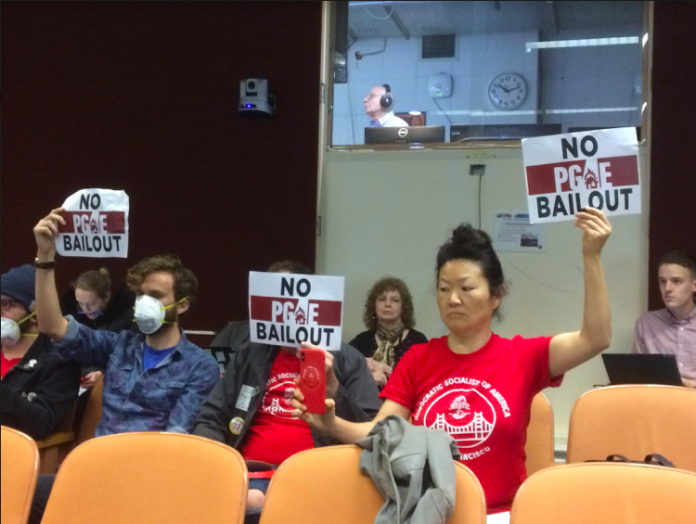
Activists shut down another hearing of the California Public Utilities Commission today, just after Pacific Gas and Electric Co. tried to head off bankruptcy by suggesting it might sell its gas division.

The protesters have another, better idea: Why not force PG&E to sell off its electric division to any city, county, or utility district that wants to set up a public-power system?
The company has reported to the SEC that its potential losses from the Camp Fire and other disasters could exceed the total assets of the company, now estimated at $15 billion. That’s a high estimate: Much of the companies hardware – power lines, transformers, etc – is old and creaky. At least $1 billion of that is the value of PG&E’s San Francisco headquarters complex, which no public-power agency would need or want.
The companies market capitalization – the cost of buying all of its stock – is now down to $8.5 billion; it was $32 billion just a year ago.
At that rate, it makes perfect sense for the state to buy it out,or to break it up into pieces and let local goverments buy it.
PG&E’s total operating revenues in 2017 were about $19 billion, and only about $4 billion and change was natural gas. At the conpany’s allowed rate of return (about 12 percent) that means natural gas brings in $480 million a year in profit. Not nothing; selling the natural gas business would bring in some cash. But I imagine it’s going to be hard to sell a gas division with heavy potential liabilities for much more than three or four times earnings. Even at ten times earnings, it’s still a modest amount of money – considering that the company is looking at $15 billion in liabilities. And PG&E doesn’t own any natural gas wells that could be considered assets; the company buys gas wholesale from suppliers and sells it retail.
Sup. Aaron Peskin has asked that $50 million of the city’s unexpected windfall surplus go to start taking over PG&E’s infrastructure in the city as a move toward establishing a safer, greener, lucrative public-power system. I have heard feedback from critics who say: Why would we give money to PG&E when we could spend it on affordable housing?
That’s the same question that the state, or a consortium of cities and counties, would face if the state Legislature had the courage to order the dissolution of PG&E and the sale of its assets to the public.
It gets harder since PG&E’s assets aren’t in great shape – and under some scenarios, the public would have to take on the liabilities for the fires.
But let’s get real: that’s going to happen anyway. The taxpayers and the ratepayers – that’s us – are going to be stuck with the costs of rebuilding big parts of the state if PG&E goes under anyway.
In theory, the state could revoke PG&E’s right to operate as a regulated utility, and start building out our own state-of-the art distribution system. In practice, that would take years, and all of the costs would come directly from the taxpayers.
Bad as it is, PG&E’s distribution system works most of the time, and would allow public-power operators to start immediately bringing in a substantial amount of cash flow, that can be used to issue bonds for a better grid.
Electricity is central to any plans for a carbon-free future. Electric cars, electric trains, electric heat for home, some day electric airplanes – that’s the way to stop burning fossil fuels.
But the plan only works if we generate electricity in a sustainable way. An electric car that issues nothing from its tailpipe but charges up from a grid that is powered by natural gas and coal does nothing, net, for the environment.
And the evidence is abundantly clear the only public ownership will lead to a sustainable generation system. PG&E will never support distributed solar, because it makes no money when people generate their own power on their roofs. That’s just one example.
So we have here a rare, remarkable opportunity to fight climate change, generate revenue for public needs, and get rid of a rogue company that has killed hundreds of people.
I ask again: Why is this even a debate?

